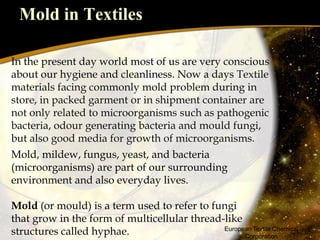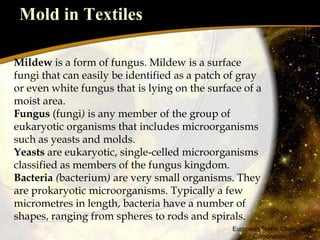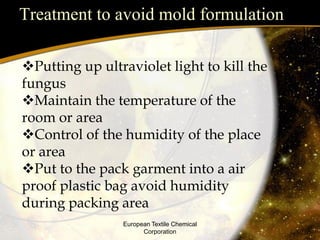Anti Mold Finishing
- 1. EUROSOFT AOAM Anti mold finishing European Textile Chemical Corporation
- 2. Mold in Textiles In the present day world most of us are very conscious about our hygiene and cleanliness. Now a days Textile materials facing commonly mold problem during in store, in packed garment or in shipment container are not only related to microorganisms such as pathogenic bacteria, odour generating bacteria and mould fungi, but also good media for growth of microorganisms. Mold, mildew, fungus, yeast, and bacteria (microorganisms) are part of our surrounding environment and also everyday lives. Mold (or mould) is a term used to refer to fungi that grow in the form of multicellular thread-like structures called hyphae. European Textile Chemical Corporation
- 3. Mold in Textiles Mildew is a form of fungus. Mildew is a surface fungi that can easily be identified as a patch of gray or even white fungus that is lying on the surface of a moist area. Fungus (fungi) is any member of the group of eukaryotic organisms that includes microorganisms such as yeasts and molds. Yeasts are eukaryotic, single-celled microorganisms classified as members of the fungus kingdom. Bacteria (bacterium) are very small organisms. They are prokaryotic microorganisms. Typically a few micrometres in length, bacteria have a number of shapes, ranging from spheres to rods and spirals. European Textile Chemical Corporation
- 4. Ideal Conditions For mold Growth Warm temperature Moisture (Humidity 70-80%, Spills) Receptive surface (skin, fabric) Sources of mold In the air we breathe In the soil In our skin and bodies & Everywhere Synthetic fibres are not totally immune to microorganisms, for example; polyurethane fibres and coatings can be damaged. Wool is more likely to suffer bacterial attack than cotton, and cotton is more likely than wool to be attacked by fungi. Mold in Textiles European Textile Chemical Corporation
- 5. Reasons of mold in textile Available starch in various fabrics. Courser and compact fabric has a greater tendency to form mold rather than finer fabric. Especially indigo dyed garment has a tendency to grow Fungus. European Textile Chemical Corporation
- 6. Precaution for mold Precaution Keep fabric or garment in dry condition Try to avoid moisture Avoid humidal moisture Control temperature Check time to time humidity available in various fabrics. Mold and Fungi cause multiple problems to textiles including discoloration, coloured stains, and fibre damage. Bacteria are not as damaging to fibres, but can produce some fibre damage, unpleasant odours and a slick, slimy feel. European Textile Chemical Corporation
- 7. Treatment to avoid mold formulation Putting up ultraviolet light to kill the fungus Maintain the temperature of the room or area Control of the humidity of the place or area Put to the pack garment into a air proof plastic bag avoid humidity during packing area European Textile Chemical Corporation
- 8. Latest technology to control anti mold or fungi Anti Mold Finish (EUROSOFT AOAM ) It is a chemical finish have been used to produce fibers, textiles or garments with demonstrable anti mold properties. The chemical is specially developed anti- microbial organic hydrophilic softener to prevent malodor from packed garments, developed due to microbial growth. A treatment with EUROSOFT AOAM protect the substrate from developing mal-odor while storage and transport. European Textile Chemical Corporation
- 9. Applying technique of Anti Mold Finishing Treated at yarn stage Treated at fabric stage Treated after garment processing Standard moisture content of fabric supposed to be 8-10%. If moisture content increases need more dose of biological softener. European Textile Chemical Corporation
- 10. Application of EUROSOFT AOAM For softening and Odor/Mold preventing from garments Eurosoft AOAM 3.0-5.0 gpl Adjust pH to 5.0-6.0 Temperature 30-40ᵒC Time 10-15 minutes For Disinfection of Hospital/Domestic Linen Eurosoft AOAM 1.0-2.0 gpl Adjust pH to 5.0-6.0 Temperature – Ambient Time Time 10-15 minutes European Textile Chemical Corporation
- 11. Application For application of soft flow machine Eurosoft AOAM 3.0-5.0 gpl Adjust pH to 5.0-6.0 Temperature – Ambient Time Time 10-15 minutes M:L - 1:3/5 For application in padding process Eurosoft AOAM 20.0-40.0 gpl Adjust pH to 5.0-6.0 Expression 55-50% Temperature – 110ᵒC Drying Time 2-3 minutes European Textile Chemical Corporation
- 12. Evaluation of anti mold finishes Test method Test name Advantage Disadvantage AATCC 100 Antibacterial finishes on textile materials Quantitative, Sensitive, realistic Time consuming AATCC 30 Antifungal activity, assessment of textile materials: Mildew and rot resistance textile materials. Semi quantitative, Agar diffusion tests Not fully realistic AATCC 147 Antibacterial assessment of textile materials: Parallel streak methods Quick, easily, inexpensive Non realistic, Non quantitative, Non reproducible AATCC 174 Antimicrobial activity assessment of carpets; qualitative and quantitative Only for carpet EuropeanTextileChemicalCorporation
- 13. Comparison of test report (AATCC 100:2012) Substrate Protocol Tests Result (%) Untreated fabric Klebsiella pneumonia (ATCC4352) % reduction of K.pneumoniae No reduction observed Staphylococc us aureus(ATCC 6538) % reduction of S.aureus No reduction observed Treated with EUROSOFT AOAM Klebsiella pneumonia (ATCC4352) % reduction of K.pneumoniae 99.9 Staphylococc us aureus(ATCC 6538) % reduction of S.aureus 99.9 European Textile Chemical Corporation
- 14. The bacterial counting European Textile Chemical Corporation
- 15. Test Result Test metho d Test protocol Result AATC C 100 % reduction of K.pneumoniae in % 100(B – A)/B = R R = % reduction A = the number of bacteria recovered from the inoculated treated test specimen swatches in the jar incubated over the desired contact period B = the number of bacteria recovered from the inoculated treated test specimen swatches in the jar immediately after inoculation (at “0” contact time) % reduction of S.aureus in % 100(B – A)/B = R R = % reduction A = the number of bacteria recovered from the inoculated treated test specimen swatches in the jar incubated over the desired contact period B = the number of bacteria recovered from the inoculated treated test specimen swatches in the jar immediately after inoculation (at “0” contact time) AATC C 30 Aspergillus Niger (ATCC 6275) Rating scale 0-2 and each number represents the degree of the mould growth observed on the surface of the specimen. 0- No growth on surface of the specimen. 1-Growth only apparent under microscope (microscopic growth) 2- Mould growth on surface of the specimen (microscopic growth) SGS IHTM Total plate count Colonies/sq cm Yeast and Mold Colonies/sq cm European Textile Chemical Corporation
- 16. Microbial infestation poses danger to both living and non- living matters. No fungus in a single garment. A treatment with EUROSOFT AOAM can ensure you no mold in your garment from today. European Textile Chemical Corporation
- 17. • • Question & Answer Any Questions?? European Textile Chemical Corporation


















